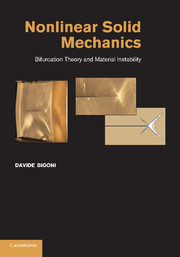Book contents
- Frontmatter
- Contents
- Preface
- Foreword by Giulio Maier
- 1 Introduction
- 2 Elements of tensor algebra and analysis
- 3 Solid mechanics at finite strains
- 4 Isotropic non-linear hyperelasticity
- 5 Solutions of simple problems in finitely deformed non-linear elastic solids
- 6 Constitutive equations and anisotropic elasticity
- 7 Yield functions with emphasis on pressure sensitivity
- 8 Elastoplastic constitutive equations
- 9 Moving discontinuities and boundary value problems
- 10 Global conditions of uniqueness and stability
- 11 Local conditions for uniqueness and stability
- 12 Incremental bifurcation of elastic solids
- 13 Applications of local and global uniqueness and stability criteria to non-associative elastoplasticity
- 14 Wave propagation, stability and bifurcation
- 15 Post-critical behaviour and multiple shear band formation
- 16 A perturbative approach to material instability
- References
- Index
- Plate section
15 - Post-critical behaviour and multiple shear band formation
Published online by Cambridge University Press: 05 August 2012
- Frontmatter
- Contents
- Preface
- Foreword by Giulio Maier
- 1 Introduction
- 2 Elements of tensor algebra and analysis
- 3 Solid mechanics at finite strains
- 4 Isotropic non-linear hyperelasticity
- 5 Solutions of simple problems in finitely deformed non-linear elastic solids
- 6 Constitutive equations and anisotropic elasticity
- 7 Yield functions with emphasis on pressure sensitivity
- 8 Elastoplastic constitutive equations
- 9 Moving discontinuities and boundary value problems
- 10 Global conditions of uniqueness and stability
- 11 Local conditions for uniqueness and stability
- 12 Incremental bifurcation of elastic solids
- 13 Applications of local and global uniqueness and stability criteria to non-associative elastoplasticity
- 14 Wave propagation, stability and bifurcation
- 15 Post-critical behaviour and multiple shear band formation
- 16 A perturbative approach to material instability
- References
- Index
- Plate section
Summary
Elastic one-dimensional models with spinodal stress/strain behaviour (involving softening and subsequent re-hardening) are employed to explain features of continued deformation after strain localisation. Global softening of the response is strongly influenced by localisation of deformation, and multiple localisation with stress oscillation is observed, as induced by the re-hardening subsequent to softening. Since one-dimensional models are not sufficient to describe the behaviour of real materials, which always deformat least in two dimensions, a simple technique (small strain, piece-wise uniform fields and fixed shear band width are assumed) is illustrated to compute the post-shear banding behaviour of a two-dimensional elastoplastic sample. Although the methodology probably is over-simplified, it is shown that it may capture important phenomena, in particular, softening and size effect, band saturation and post-saturation, leading tomultiple band formation with possible stress fluctuations or delayed softening. All these phenomena are important in the understanding of the mechanical behaviour of many materials, in particular, granular materials.
Analysis of the behaviour of a material element after shear banding has occurred is crucial for an understanding of induced softening and size-effect phenomena, which may be relevant for different purposes, for instance, predicting possible catastrophic failure of structural elements (see the Introduction). Moreover, post-shear banding may involve multiple shear band formation, a phenomenon observed in different materials: foams (Moore et al., 2006), ductile metals (Hall, 1970), honeycombs (Papka and Kyriakides, 1999), sand (Finno et al., 1997), shape memory alloys (Shaw and Kyriakides, 1997) and the stacks of drinking straws shown in the Introduction (Section 1.6).
- Type
- Chapter
- Information
- Nonlinear Solid MechanicsBifurcation Theory and Material Instability, pp. 427 - 443Publisher: Cambridge University PressPrint publication year: 2012

